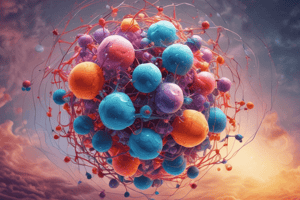Podcast
Questions and Answers
What is the characteristic structure of solids?
What is the characteristic structure of solids?
- Random movement in all directions
- Fixed and regular structure (correct)
- No forces of attraction between particles
- Irregular with free movement of particles
Gases have the highest density among the three states of matter.
Gases have the highest density among the three states of matter.
False (B)
What is the formula for calculating density?
What is the formula for calculating density?
Density = Mass / Volume
The energy required to change the state of one kilogram of a substance without changing its temperature is called __________.
The energy required to change the state of one kilogram of a substance without changing its temperature is called __________.
Match the following states of matter with their characteristics:
Match the following states of matter with their characteristics:
Which statement regarding internal energy is true?
Which statement regarding internal energy is true?
To find the density of an irregular object, you can use standard volume formulas.
To find the density of an irregular object, you can use standard volume formulas.
What happens to the kinetic energy of particles when a system is heated?
What happens to the kinetic energy of particles when a system is heated?
Flashcards
Internal Energy
Internal Energy
The total energy stored within a system's particles, including both kinetic and potential energy.
Specific Latent Heat
Specific Latent Heat
The amount of energy required to change the state of one kilogram of a substance without affecting its temperature.
Density
Density
A measure of how much mass is contained within a given volume.
Gas Pressure
Gas Pressure
Signup and view all the flashcards
Solids
Solids
Signup and view all the flashcards
Liquids
Liquids
Signup and view all the flashcards
Gases
Gases
Signup and view all the flashcards
Particle Model of Matter
Particle Model of Matter
Signup and view all the flashcards
Study Notes
Particle Model
-
The particle model of matter describes substances in terms of particles and their properties: solids, liquids, and gases.
-
Solids
- Have strong forces of attraction between particles, forming a fixed and regular structure.
- Particles vibrate in place when energy is transferred, like a Mexican wave.
- Solids have a high particle density due to the close arrangement of particles.
-
Liquids
- Have weaker forces of attraction between particles, resulting in an irregular structure.
- Particles move past each other freely and possess more energy compared to solids.
- Liquids are less dense than solids due to the greater space between particles.
-
Gases
- Have negligible forces of attraction between particles, leading to free, random movement in all directions.
- Gas particles have the highest energy among the three states, constantly moving and filling their containers.
- Gases have a low density due to the vast space between particles.
Density
- Density is a measure of how much mass is contained within a given volume.
- The formula for density is: Density = Mass / Volume
- The unit for density is kg/m³.
Finding the Density of Objects
- For regular objects (cubes, cuboids, cylinders), density can be calculated using standard volume formulas.
- For irregular objects, use the method of water displacement:
- Fill a Eureka can with water to the maximum height.
- Submerge the object fully in the water.
- Collect the displaced water in another container.
- The volume of displaced water is equivalent to the volume of the object.
- Calculate density using Mass / Volume.
Internal Energy
- Internal energy is the total energy stored within a system's particles, encompassing both kinetic and potential energy.
- Heating a system increases the kinetic energy of its particles, making them move faster and ultimately increasing the system's internal energy.
- If internal energy increases sufficiently, it can induce a change in the state of matter.
Specific Latent Heat
- Specific latent heat is the amount of energy required to change the state of one kilogram of a substance, without affecting its temperature.
- During a change of state, energy is used to break bonds between particles, preventing temperature increases.
- The formula for energy during a change of state is: Energy = Mass x Specific Latent Heat.
Pressure in Gases
- Gas pressure is the force exerted by gas particles per unit area.
- Gases move randomly within a container, colliding with the container walls and other particles.
- The pressure in a sealed container is determined by the total force exerted on its walls.
- As the space for gas particles decreases, they collide more frequently with the walls, leading to a higher pressure.
Particle Motion in Gases
- The smaller the space available for a fixed number of gas particles, the higher the pressure will be due to increased collision frequencies.
Studying That Suits You
Use AI to generate personalized quizzes and flashcards to suit your learning preferences.




